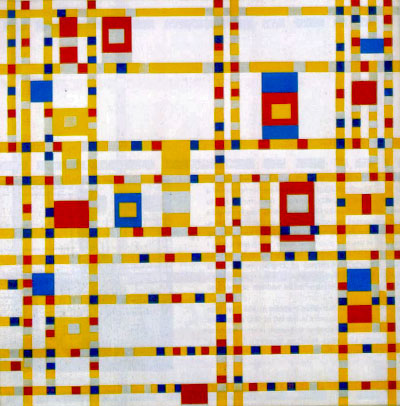On this date three hundred and seventy five years ago a Dutch official named Pieter Minuit bought Manhattan Island from the Native Americans for sixty guilders’-worth of knives, cloth and beads. Today’s picture is Mondrian’s celebrated Broadway Boogie-Woogie: another case of a Dutchman called Pieter taking possession of Manhattan, albeit this time in the realm of art.
Mondrian arrived in New York as a refugee from war in 1940. He had fled his longtime home of Paris just two years earlier, when the threat of German invasion persuaded him to move to London. After a bomb narrowly missed his peaceful whitewashed studio in Hampstead he had resolved to leave Europe altogether. The form he was required to fill out for Immigration on entering the United States still survives, complete with an attached photograph of the bespectacled painter looking understandably tense. Under “Visible Distinctive Marks” he wrote “slightly bald”; under “Marital Status”, “not married”. Mondrian was in his late sixties, his health was poor and he sensed that little time was left to him. A lifelong bachelor, who pursued his artistic goals with all the dedication of an ascetic, he believed that the New World would provide him with the stimulus for new paintings. His optimism proved to be well founded.
Mondrian’s Manhattan address was 353 East 56th Street, central enough for him to feel he was at the very hub of the world’s liveliest city. He had come to believe that it was the sacrosanct task of the artist both to embrace and to shape all that was truly modern in the modern world; to pursue the ideal of progress with utter singlemindedness and, in doing so, to rid himself utterly of the residue of the past. Manhattan was his utopia: a place, as he said, where “We...

ITP 55: Broadway Boogie-Woogie, by Piet Mondrian
06-05-2001

